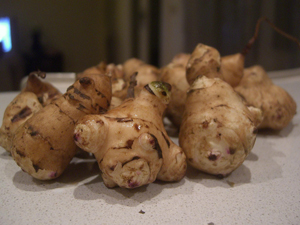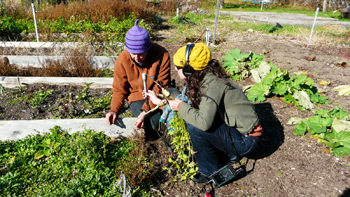Recipes from Eva's Garden
Published: February 6, 2018
By Jessica Ilyse Kurn

Eva Sommaripa and Didi Emmons cook up a storm in the kitchen. (Photo: Jessica Ilyse Kurn)
Try out some Autumnal recipes from Eva's Garden.
Eva Sommaripa is the subject of a new book, Wild Flavors: One Chef's Transformative Year Cooking from Eva's Farm (Chelsea Green, 2011).
Written by Chef Didi Emmons, this book profiles Eva's unconventional methods of eating edible weeds, and saving everything (like pickle water, once the pickles are gone). It also reveals the bond between these two women--both captivated by all things culinary.
Below are two Autumnal recipes from the book.
Sunchoke Dumplings with Swiss Chard and Walnuts
Eva says this dish oozes umami, a Japanese word for a taste sensation of meaty or savory, produced by several amino acids typically found in meats, cheeses, broths, stocks, and other protein-heavy foods. It is not always easy for a vegetarian dish to achieve this satisfying meaty quality. I think it is the earthy flavor of the chokes and chard, as well as the rich texture of dumplings, that does it.
|
|
MAKES 3 OR 4 SERVINGS
11⁄4 pounds sunchokes
2 large eggs
1⁄2 teaspoon salt or more to taste
13⁄4 cups white whole-wheat flour (or unbleached white flour)
4 tablespoons butter, softened
4 tablespoons chopped walnuts
1 leek, chopped into 1⁄2-inch pieces
1 large garlic clove, minced
1 bunch Swiss chard, chopped into 1-inch pieces
4 tablespoons grated blue cheese (Gorgonzola, Stilton, or any artisan blue)
1. Scrub the sunchokes clean under warm running water. You may want to peel them if the skin is tough. Using a steamer, cook the sunchokes for about 20 minutes, until they are tender.
2. Mash the steamed sunchokes in a bowl with a fork. Add the eggs and salt and mix well. Incorporate the flour 1⁄2 cup at a time, mixing well after each addition. The mixture should be soft and sticky.
3. Bring a large pot of salted water to a boil.
4. Meanwhile, heat the butter in a large skillet over medium heat. Add the walnuts and cook, stirring regularly, until they are toasted, about 7 minutes. Remove the walnuts from the skillet with a slotted spoon, and set aside
5. Add the leeks and garlic to the skillet and cook for 4 minutes or so, stirring. Add the chard and cook, stirring, until the chard is wilted and cooked through, about 2 minutes. Remove the skillet from the heat.
6. With an oiled spoon and your finger, take spoonfuls of the sunchoke dough and drop them into the boiling water. Continue until all the dough is used. (If you have leftover batter, make it into pancakes the following morning, cooking them in butter.) As the dumplings rise to the surface, remove them from the boiling water with a slotted spoon and place them in the skillet with the chard mixture. Stir in the walnuts.
7. Heat the chard and dumplings to the desired temperature on the stovetop over medium heat. Spoon the mixture onto plates, then top with grated cheese.
Vegan Parsnip and Wild Mushroom Pie
This recipe takes a little time but it’s a festive pie that’s perfect for friends who are vegan. If you want to save time, you could buy a pie shell. If you prefer butter, then go right ahead and use it in the pastry in place of the margarine and likewise, if you’d prefer cow’s milk instead of soy milk, feel free to use it. Serve with some home- made cranberry salsa (page 33) if the holidays are near.
|
|
SERVES 6
Vegan Piecrust:
2 cups whole wheat flour
1⁄2 teaspoon salt
10 tablespoons margarine
4 or 5 tablespoons ice-cold water
Parsnip and Mushroom Filling:
1 pound potatoes (russet, all-purpose, or any local variety), scrubbed and quartered
1 pound parsnips, scrubbed and quartered
4 tablespoons extra-virgin olive oil
1 cup soy milk or soy creamer
Salt and freshly cracked black pepper
2 large onions, thinly sliced
1 tablespoons balsamic vinegar
12 ounces wild mushrooms, shiitakes, or portobellos, cut into small cubes
6 garlic cloves, minced
1 tablespoon minced fresh thyme or sage (optional)
1. To make the piecrust, lightly stir together the flour and salt in a medium bowl. Cut the margarine into the flour mixture until it resembles coarse crumbs, using a pastry cutter or two knives. Sprinkle in ice-cold water, a tablespoon at a time, mixing lightly with a fork after each addition, until the pastry just holds together. (Alternatively, you could do the mixing in a food processor, pulsing the machine to cut in the butter and mix in the water.)
2. With your hands, shape the pastry into a ball and let it rest on a plate in the fridge for 30 minutes; chilling it makes it more pliable.
3. Lightly flour a work surface and rolling pin. Roll the pastry on the floured surface into a ⅛-inch-thick circle, rolling the pin straight away from you, while turning the pastry after every roll. Make it 2 inches larger all around than the pie plate you are using (I use a 9-inch pie pan).
4. Transfer the pastry to the pie plate. The easiest way to do this is to roll half of it up onto the rolling pin, drape the loose edge over one edge of the pie plate, and unroll, easing the pastry into the bottom and sides of the pie plate. With scissors or a sharp knife, trim the pastry edges, leaving a 1-inch overhang all around the pie plate rim. Fold under the overhanging dough, and pinch a high edge all around the rim of the pie plate. Then freeze for 20 minutes.
5. Preheat the oven to 400 degrees F.
6. Remove the piecrust from the freezer. Arrange strips of aluminum foil over its high edges to keep them from slumping or burning. Bake for 15 minutes, then let cool.
7. To roast the vegetables for the filling, toss the potatoes and parsnips with 1 tablespoon of the olive oil and half the garlic. Arrange in a single layer on a baking sheet and roast in the 400-degree oven for about 30 minutes, until tender. Transfer to a large bowl and mash them with a potato masher. Stir in soy milk, and season to taste with salt and freshly cracked pepper.
8. Caramelize the onions: Heat 1 tablespoon of the olive oil in a large skillet over medium heat. Add the onions and cook, stirring every few minutes, for 10 minutes. Reduce the heat to low and continue to cook, stirring every few minutes. When the onions start sticking to the pan, let them stick a little and brown, but then stir them before they burn. The trick is to leave them alone enough to brown (if you stir them too often, they won’t brown), but not so long so that they burn. Cook until the onions are quite brown, about 15 to 20 minutes, adding the vinegar a minute or two before you turn the heat off. Season with salt and freshly cracked black pepper and remove the onions to a plate.
9. In the same skillet, heat the remaining 2 tablespoons olive oil over medium-high heat. Add the mushrooms, garlic, and thyme (if using) and sauté for 5 minutes, stirring intermittently. Remove from the heat.
10. Spread the mushrooms over the bottom of the parbaked piecrust, then spoon the parsnip mixture over them, and spread the onions on top. Bake for 20 minutes, and serve garnished with thyme sprigs if desired.
|
|
Back to Living on Earth
Living on Earth wants to hear from you!
Living on Earth
62 Calef Highway, Suite 212
Lee, NH 03861
Telephone: 617-287-4121
E-mail: comments@loe.org
Newsletter [Click here]
Donate to Living on Earth!
Living on Earth is an independent media program and relies entirely on contributions from listeners and institutions supporting public service. Please donate now to preserve an independent environmental voice.
NewsletterLiving on Earth offers a weekly delivery of the show's rundown to your mailbox. Sign up for our newsletter today!
 Sailors For The Sea: Be the change you want to sea.
Sailors For The Sea: Be the change you want to sea.
 The Grantham Foundation for the Protection of the Environment: Committed to protecting and improving the health of the global environment.
The Grantham Foundation for the Protection of the Environment: Committed to protecting and improving the health of the global environment.
 Contribute to Living on Earth and receive, as our gift to you, an archival print of one of Mark Seth Lender's extraordinary wildlife photographs. Follow the link to see Mark's current collection of photographs.
Contribute to Living on Earth and receive, as our gift to you, an archival print of one of Mark Seth Lender's extraordinary wildlife photographs. Follow the link to see Mark's current collection of photographs.
 Buy a signed copy of Mark Seth Lender's book Smeagull the Seagull & support Living on Earth
Buy a signed copy of Mark Seth Lender's book Smeagull the Seagull & support Living on Earth




